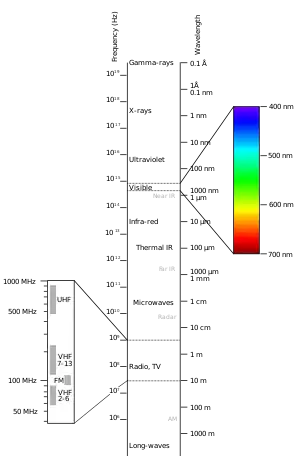Spectral imaging
Spectral imaging is imaging that uses multiple bands across the electromagnetic spectrum. While an ordinary camera captures light across three wavelength bands in the visible spectrum, red, green, and blue (RGB), spectral imaging encompasses a wide variety of techniques that go beyond RGB. Spectral imaging may use the infrared, the visible spectrum, the ultraviolet, x-rays, or some combination of the above. It may include the acquisition of image data in visible and non-visible bands simultaneously, illumination from outside the visible range, or the use of optical filters to capture a specific spectral range. It is also possible to capture hundreds of wavelength bands for each pixel in an image.

Multispectral imaging captures a small number of spectral bands, typically three to fifteen, through the use of varying filters and illumination. Many off-the-shelf RGB cameras will detect a small amount of Near-Infrared (NIR) light. A scene may be illuminated with NIR light, and, simultaneously, an infrared-passing filter may be used on the camera to ensure that visible light is blocked and only NIR is captured in the image. Industrial, military, and scientific work, however, uses sensors built for the purpose.
Hyperspectral imaging is another subcategory of spectral imaging, which combines spectroscopy and digital photography. In hyperspectral imaging, a complete spectrum or some spectral information (such as the Doppler shift or Zeeman splitting of a spectral line) is collected at every pixel in an image plane. A hyperspectral camera uses special hardware to capture hundreds of wavelength bands for each pixel, which can be interpreted as a complete spectrum. In other words, the camera has a high spectral resolution. The phrase "spectral imaging" is sometimes used as a shorthand way of referring to this technique, but it is preferable to use the term "hyperspectral imaging" in places when ambiguity may arise. Hyperspectral images are often represented as an image cube, which is type of data cube.[1]
Applications of spectral imaging include art conservation, astronomy, solar physics, planetology, and Earth remote sensing.
References
- "Visualization and Analysis of Spectral Data Cubes an Hipe toolbox (sic)" (PDF). herschel.esac.esa.int. 2008-12-04. Retrieved 2017-04-28.
